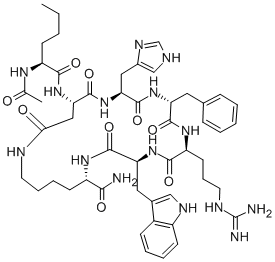| Description |
Melanotan II is a synthetic analogue of the melanocortin peptide hormone alpha-melanocyte stimulating hormone (α-MSH) that occurs naturally. In usage, Melanotan II has been revealed to have aphrodisiac and melanogenesis (tanning) effects that have been subjected to clinical trials and preliminary studies. The compound is a cyclic lactam analogue of α-MSH that has an amino sequence named MTII (Ac-Nle-c[Asp-His-D-Phe-Arg-Trp-Lys]-NH2). Notably, no government drug regulatory agency across the world had approved for the use of any compound incorporating the Melanotan II peptide by 2010 |
| Historical Development |
Melanotan II was first developed at the University of Arizona. Various studies conducted at the institution confirmed that the best defence against skin cancer was melanin activated in the skin, a tan. The researchers assumed that an effective procedure to reduce the rates of skin cancer in individuals would be by inducing the body’s natural pigmentary system to produce a tan that would be protective before exposure to UV. Melanogenesis is a process by which the skin’s pigment cells (melanocytes) produce the hormone α-MSH naturally causes the skin's pigment (melanin).
After numerous clinical trials by administration of the endogenous hormone to the body, the scientists found that though it appeared to work, α-MSH had a very short half-life in the body to be practical as a therapeutic drug. Therefore, they opted to look for a more stable and potent alternative that would be more practical. Subsequently, after numerous trials, they developed Melanotan I and after that Melanotan II. |
| Uses |
Malanotan II is used for tanning of the skin and producing of erections in men with erectile dysfunction when administered as a shot under the skin. Malanotan II is safe when used under strict medical supervision for treating erectile dysfunction. However, it may cause stomach cramps, tiredness, nausea, spontaneous erections of the penis, and darkened skin. |
| BENEFITS OF A MELANOTAN II |
Darker tan with less exposure to UV radiation
Tanning without sunburn, even for fair-skinned individuals
Possible reduction in the risk of Melanoma (skin cancer)
Possible reduction in the incidence of sun-damaged skin
Possible reduction in body fat
No sunburn, n tan lines
No sunless tanning streaks or fake tan removal
Possible increase libido
During clinical trials for its use as a tanning agent, melanotan II was found to be a potent stimulator of male erections. It has also been shown to increase female sexual desire in patients with sexual arousal disorder). |
| Uses |
Melanotan II acetate salt has been used to study its inhibitory effects on feeding and energy expenditure in rats. It is a lab-made chemical that is similar to a hormone found in people. Melanotan II has been shown to have melanogenesis (tanning) and aphrodisiac effects on humans. |



